Dihydrocaffeic Acid—Is It the Less Known but Equally Valuable Phenolic Acid?
Abstract
1. Introduction
2. The Occurrence of Dihydrocaffeic Acid and Its Derivatives
3. Biosynthesis of Dihydrocaffeic Acid
4. Metabolism of Dihydrocaffeic Acid by Intestinal and Lactic Acid Bacteria
5. Recent Advances in the Enzymatic Synthesis of Dihydrocaffeic Acid Derivatives
6. Biological Activity of Dihydrocaffeic Acid and Its Derivatives
6.1. Antioxidant Activity
6.2. Anti-Inflammatory Activity
6.3. Cytoprotective Activity
6.4. Anticancer Activity
6.5. Enzyme Inhibitory Activity
6.6. Hydrogels, Resins and Polymers Preparation for Biomedical Application
6.7. Antimicrobial Activity
6.8. Antiviral Activity
6.9. Repellent Activity, Avoidance Response in Caenorhabditis elegans and Insecticidal Activity
6.10. The Complexation of Metals by Dihydrocaffeic Acid
6.11. Other Biological Properties of Dihydrocaffeic Acid and Its Derivatives
7. Conclusions
Funding
Institutional Review Board Statement
Informed Consent Statement
Data Availability Statement
Conflicts of Interest
References
- Zieniuk, B.; Ononamadu, C.J.; Jasińska, K.; Wierzchowska, K.; Fabiszewska, A. Lipase-Catalyzed Synthesis, Antioxidant Activity, Antimicrobial Properties and Molecular Docking Studies of Butyl Dihydrocaffeate. Molecules 2022, 27, 5024. [Google Scholar] [CrossRef] [PubMed]
- Compound Summary 3-(3,4-Dihydroxyphenyl)Propionic Acid. Available online: https://pubchem.ncbi.nlm.nih.gov/compound/3-_3_4-Dihydroxyphenyl_propionic-acid (accessed on 30 March 2023).
- Hartleb, I.; Seifert, K. Acid Constituents from Isatis tinctoria. Planta Med. 1995, 61, 95–96. [Google Scholar] [CrossRef] [PubMed]
- Nakurte, I.; Berga, M.; Pastare, L.; Kienkas, L.; Senkovs, M.; Boroduskis, M.; Ramata-Stunda, A. Valorization of Bioactive Compounds from By-Products of Matricaria recutita White Ray Florets. Plants 2023, 12, 396. [Google Scholar] [CrossRef]
- Zhou, X.; Zhou, M.; Liu, Y.; Ye, Q.; Gu, J.; Luo, G. Isolation and Identification of Antioxidant Compounds from Gynura bicolor Stems and Leaves. Int. J. Food Prop. 2016, 19, 233–241. [Google Scholar] [CrossRef]
- Fraga, B.M.; Gonzalez-Coloma, A.; Alegre-Gomez, S.; Lopez-Rodriguez, M.; Amador, L.J.; Diaz, C.E. Bioactive constituents from transformed root cultures of Nepeta teydea. Phytochemistry 2017, 133, 59–68. [Google Scholar] [CrossRef]
- Chang, Y.C.; Chang, F.R.; Wu, Y.W. The Constituents of Lindera glauca. J. Chin. Chem. Soc. 2000, 47, 373–380. [Google Scholar] [CrossRef]
- Feng, W.S.; Zhu, B.; Zheng, X.K.; Zhang, Y.L.; Yang, L.G.; Li, Y.J. Chemical Constituents of Selaginella stautoniana. Chin. J. Nat. Med. 2011, 9, 108–111. [Google Scholar]
- Buchanan, M.S.; Carroll, A.R.; Edser, A.; Parisot, J.; Addepalli, R.; Quinn, R.J. Tyrosine kinase inhibitors from the rainforest tree Polyscias murrayi. Phytochemistry 2005, 66, 481–485. [Google Scholar] [CrossRef]
- van Rensburg, C.J.; Erasmus, E.; Loots, D.T.; Oosthuizen, W.; Jerling, J.C.; Kruger, H.S.; Louw, R.; Brits, M.; van der Westhuizen, F.H. Rosa roxburghii supplementation in a controlled feeding study increases plasma antioxidant capacity and glutathione redox state. Eur. J. Nutr. 2005, 44, 452–457. [Google Scholar] [CrossRef]
- Alvarez-Suarez, J.M.; Giampieri, F.; Brenciani, A.; Mazzoni, L.; Gasparrini, M.; Gonzalez-Paramas, A.M.; Santos-Buelga, C.; Morroni, G.; Simoni, S.; Forbes-Hernandez, T.Y.; et al. Apis mellifera vs. Melipona beecheii Cuban polifloral honeys: A comparison based on their physicochemical parameters, chemical composition and biological properties. LWT 2018, 87, 272–279. [Google Scholar] [CrossRef]
- Mansouri, A.; Embarek, G.; Kokkalou, E.; Kefalas, P. Phenolic profile and antioxidant activity of the Algerian ripe date palm fruit (Phoenix dactylifera). Food Chem. 2005, 89, 411–420. [Google Scholar] [CrossRef]
- Owen, R.W.; Haubner, R.; Mier, W.; Giacosa, A.; Hull, W.E.; Spiegelhalder, B.; Bartsch, H. Isolation, structure elucidation and antioxidant potential of the major phenolic and flavonoid compounds in brined olive drupes. Food Chem. Toxicol. 2003, 41, 703–717. [Google Scholar] [CrossRef]
- Bianco, A.; Uccella, N. Biophenolic components of olives. Food Res. Int. 2000, 33, 475–485. [Google Scholar] [CrossRef]
- Senizza, B.; Ganugi, P.; Trevisan, M.; Lucini, L. Combining untargeted profiling of phenolics and sterols, supervised multivariate class modelling and artificial neural networks for the origin and authenticity of extra-virgin olive oil: A case study on Taggiasca Ligure. Food Chem. 2023, 404, 134543. [Google Scholar] [CrossRef]
- Boselli, E.; Giomo, A.; Minardi, M.; Frega, N.G. Characterization of phenolics in Lacrima di Morro d’Alba wine and role on its sensory attributes. Eur. Food Res. Technol. 2008, 227, 709–720. [Google Scholar] [CrossRef]
- Madrera, R.R.; Lobo, A.P.; Valles, B.S. Phenolic Profile of Asturian (Spain) Natural Cider. J. Agric. Food. Chem. 2006, 54, 120–124. [Google Scholar] [CrossRef] [PubMed]
- Suarez, B.; Palacios, N.; Fraga, N.; Rodriguez, R. Liquid chromatographic method for quantifying polyphenols in ciders by direct injection. J. Chromatogr. A 2005, 1066, 105–110. [Google Scholar] [CrossRef]
- Yang, X.; Wei, S.; Liu, B.; Guo, D.; Zheng, B.; Feng, L.; Liu, Y.; Tomas-Barberan, F.A.; Luo, L.; Huang, D. A novel integrated non-targeted metabolomic analysis reveals significant metabolite variations between different lettuce (Lactuca sativa L.) varieties. Hortic. Res. 2018, 25, 33. [Google Scholar] [CrossRef]
- Kim, J.Y.; Cho, J.Y.; Lee, K.D.; Choi, G.C.; Kim, S.J.; Ham, K.S.; Moon, J.H. Change of Phenylpropanoic Acid and Flavonol Contents at Different Growth Stage of Glasswort (Salicornia herbacea L.). Food Sci. Biotechnol. 2014, 23, 685–691. [Google Scholar] [CrossRef]
- Hwang, Y.P.; Yun, H.J.; Chun, H.K.; Chung, Y.C.; Kim, H.K.; Jeong, M.H.; Yoon, T.R.; Jeong, H.G. Protective mechanisms of 3-caffeoyl, 4-dihydrocaffeoyl quinic acid from Salicornia herbacea against tert-butyl hydroperoxide-induced oxidative damage. Chem. Biol. Interact. 2009, 181, 366–376. [Google Scholar] [CrossRef]
- Chung, Y.C.; Choi, J.H.; Oh, K.N.; Chun, H.K.; Jeong, H.G. Tungtungmadic Acid Isolated from Salicornia herbacea Suppresses the Progress of Carbon Tetrachloride-induced Hepatic Fibrosis in Mice. Toxicol. Res. 2006, 22, 267–273. [Google Scholar]
- Chung, Y.C.; Chun, H.K.; Yang, J.Y.; Kim, J.Y.; Han, E.H.; Kho, Y.H.; Jeong, H.G. Tungtungmadic Acid, a Novel Antioxidant, from Salicornia herbacea. Arch. Pharmacal Res. 2005, 28, 1122–1126. [Google Scholar] [CrossRef] [PubMed]
- Kim, J.Y.; Cho, J.Y.; Ma, Y.K.; Park, K.Y.; Lee, S.H.; Ham, K.S.; Lee, H.J.; Park, K.H.; Moon, J.H. Dicaffeoylquinic acid derivatives and flavonoid glucosides from glasswort (Salicornia herbacea L.) and their antioxidative activity. Food Chem. 2011, 125, 55–62. [Google Scholar] [CrossRef]
- Zidorn, C.; Petersen, B.O.; Udovicić, V.; Larsen, T.O.; Duus, J.O.; Rollinger, J.M.; Ongania, K.H.; Ellmerer, E.P.; Stuppner, H. Podospermic acid, 1,3,5-tri-O-(7,8-dihydrocaffeoyl)quinic acid from Podospermum laciniatum (Asteraceae). Tetrahedron Lett. 2005, 46, 1291–1294. [Google Scholar] [CrossRef]
- Tsevegsuren, N.; Edrada, R.; Lin, W.; Ebel, R.; Torre, C.; Ortlepp, S.; Wray, V.; Proksch, P. Biologically Active Natural Products from Mongolian Medicinal Plants Scorzonera divaricata and Scorzonera pseudodivaricata. J. Nat. Prod. 2007, 70, 962–967. [Google Scholar] [CrossRef] [PubMed]
- Funayama, S.; Yoshida, K.; Konno, C.; Hikino, H. Structure of Kukoamine A, a Hypotensive Principle of Lycium chinense Root Barks. Tetrahedron Lett. 1980, 21, 1355–1356. [Google Scholar] [CrossRef]
- Funayama, S.; Zhang, G.R.; Nozoe, S. Kukoamine B, a Spermine Alkaloid from Lycium chinense. Phytochemistry 1995, 38, 1529–1531. [Google Scholar] [CrossRef]
- Parr, A.J.; Mellon, F.A.; Colquhoun, I.J.; Davies, H.V. Dihydrocaffeoyl Polyamines (Kukoamine and Allies) in Potato (Solanum tuberosum) Tubers Detected during Metabolite Profiling. J. Agric. Food Chem. 2005, 53, 5461–5466. [Google Scholar] [CrossRef]
- Shah, S.R.; Ukaegbu, C.I.; Hamid, H.A.; Alara, O.R. Evaluation of antioxidant and antibacterial activities of the stems of Flammulina velutipes and Hypsizygus tessellatus (white and brown var.) extracted with different solvents. J. Food Meas. Charact. 2018, 12, 1947–1961. [Google Scholar] [CrossRef]
- Forero, D.P.; Masatani, C.; Fujimoto, Y.; Coy-Barrera, E.; Peterson, D.G.; Osorio, C. Spermidine Derivatives in Lulo (Solanum quitoense Lam.) Fruit: Sensory (Taste) versus Biofunctional (ACE-Inhibition) Properties. J. Agric. Food Chem. 2016, 64, 5375–5383. [Google Scholar] [CrossRef]
- Wittayalai, S.; Sathalalai, S.; Thorroad, S.; Worawittayanon, P.; Ruchirawat, S.; Thasana, N. Lycophlegmariols A–D: Cytotoxic serratene triterpenoids from the club moss Lycopodium phlegmaria L. Phytochemistry 2012, 76, 117–123. [Google Scholar] [CrossRef] [PubMed]
- Nguyen, H.T.; Doan, H.T.; Ho, D.V.; Pham, K.T.; Raal, A.; Morita, H. Huperphlegmines A and B, two novel Lycopodium alkaloids with an unprecedented skeleton from Huperzia phlegmaria, and their acetylcholinesterase inhibitory activities. Fitoterapia 2018, 129, 267–271. [Google Scholar] [CrossRef]
- Białecka-Florjańczyk, E.; Fabiszewska, A.; Zieniuk, B. Phenolic Acids Derivatives-Biotechnological Methods of Synthesis and Bioactivity. Curr. Pharm. Biotechnol. 2018, 19, 1098–1113. [Google Scholar] [CrossRef]
- KEGG Phenylalanine, Tyrosine and Tryptophan Biosynthesis—Reference Pathway. Available online: https://www.genome.jp/pathway/map00400 (accessed on 30 March 2023).
- KEGG Phenylpropanoid Biosynthesis—Reference Pathway. Available online: https://www.genome.jp/pathway/map00940 (accessed on 30 March 2023).
- KEGG Tyrosine Metabolism—Reference Pathway. Available online: https://www.genome.jp/pathway/map00350 (accessed on 30 March 2023).
- Soares, A.R.; Marchiosi, R.; de Cassia Siqueira-Soares, R.; de Lima, R.B.; dos Santos, W.D.; Ferrarese-Filho, O. The role of L-DOPA in plants. Plant Signal. Behav. 2014, 9, e28275. [Google Scholar] [CrossRef]
- Ibdah, M.; Berim, A.; Martens, S.; Valderrama, A.L.H.; Palmieri, L.; Lewinsohn, E.; Gang, D.R. Identification and cloning of an NADPH-dependent hydroxycinnamoyl-CoA double bond reductase involved in dihydrochalcone formation in Malus×domestica Borkh. Phytochemistry 2014, 107, 24–31. [Google Scholar] [CrossRef]
- Redeuil, K.; Smarrito-Menozzi, C.; Guy, P.; Rezzi, S.; Dionisi, F.; Williamson, G.; Nagy, K.; Renouf, M. Identification of novel circulating coffee metabolites in human plasma by liquid chromatography–mass spectrometry. J. Chromatogr. A 2011, 1218, 4678–4688. [Google Scholar] [CrossRef]
- Lang, R.; Dieminger, N.; Beusch, A.; Lee, Y.M.; Dunkel, A.; Suess, B.; Skurk, T.; Wahl, A.; Hauner, H.; Hofmann, T. Bioappearance and pharmacokinetics of bioactives upon coffee consumption. Anal. Bioanal. Chem. 2013, 405, 8487–8503. [Google Scholar] [CrossRef] [PubMed]
- Scherbl, D.; Renouf, M.; Marmet, C.; Poquet, L.; Cristiani, I.; Dahbane, S.; Emady-Azar, S.; Sauser, J.; Galan, J.; Dionisi, F.; et al. Breakfast consumption induces retarded release of chlorogenic acid metabolites in humans. Eur. Food Res. Technol. 2017, 243, 791–806. [Google Scholar] [CrossRef]
- de Oliveira, D.M.; Sampaio, G.R.; Pinto, C.B.; Catharino, R.R.; Markowicz Bastos, D.H. Bioavailability of chlorogenic acids in rats after acute ingestion of maté tea (Ilex paraguariensis) or 5-caffeoylquinic acid. Eur. J. Nutr. 2017, 56, 2541–2556. [Google Scholar] [CrossRef]
- Urpi-Sarda, M.; Monagas, M.; Khan, N.; Lamuela-Raventos, R.M.; Santos-Buelga, C.; Sacanella, E.; Castell, M.; Permanyer, J.; Andres-Lacueva, C. Epicatechin, procyanidins, and phenolic microbial metabolites after cocoa intake in humans and rats. Anal. Bioanal. Chem. 2009, 394, 1545–1556. [Google Scholar] [CrossRef]
- Wittemer, S.M.; Ploch, M.; Windeck, T.; Muller, S.C.; Drewelow, B.; Derendorf, H.; Veit, M. Bioavailability and pharmacokinetics of caffeoylquinic acids and flavonoids after oral administration of Artichoke leaf extracts in humans. Phytomedicine 2005, 12, 28–38. [Google Scholar] [CrossRef] [PubMed]
- Azzini, E.; Bugianesi, R.; Romano, F.; Di Venere, D.; Miccadei, S.; Durazzo, A.; Foddai, M.S.; Catasta, G.; Linsalata, V.; Maiani, G. Absorption and metabolism of bioactive molecules after oral consumption of cooked edible heads of Cynara scolymus L. (cultivar Violetto di Provenza) in human subjects: A pilot study. Br. J. Nutr. 2007, 97, 963–969. [Google Scholar] [CrossRef] [PubMed]
- Ancillotti, C.; Ulaszewska, M.; Mattivi, F.; Del Bubba, M. Untargeted Metabolomics Analytical Strategy Based on Liquid Chromatography/Electrospray Ionization Linear Ion Trap Quadrupole/Orbitrap Mass Spectrometry for Discovering New Polyphenol Metabolites in Human Biofluids after Acute Ingestion of Vaccinium myrtillus Berry Supplement. J. Am. Soc. Mass Spectrom. 2019, 30, 381–402. [Google Scholar] [CrossRef]
- Bøhn, S.K.; Myhrstad, M.C.W.; Thoresen, M.; Erlund, I.; Vasstrand, A.K.; Marciuch, A.; Carlsen, M.H.; Bastani, N.E.; Engedal, K.; Flekkøy, K.M.; et al. Bilberry/red grape juice decreases plasma biomarkers of inflammation and tissue damage in aged men with subjective memory impairment—A randomized clinical trial. BMC Nutr. 2021, 7, 75. [Google Scholar] [CrossRef]
- Bazzocco, S.; Mattila, I.; Guyot, S.; Renard, C.M.G.C.; Aura, A.M. Factors affecting the conversion of apple polyphenols to phenolic acids and fruit matrix to short-chain fatty acids by human faecal microbiota In Vitro. Eur. J. Nutr. 2008, 47, 442–452. [Google Scholar] [CrossRef] [PubMed]
- Kahle, K.; Kempf, M.; Schreier, P.; Scheppach, W.; Schrenk, D.; Kautenburger, T.; Hecker, D.; Huemmer, W.; Ackermann, M.; Richling, E. Intestinal transit and systemic metabolism of apple polyphenols. Eur. J. Nutr. 2011, 50, 507–522. [Google Scholar] [CrossRef] [PubMed]
- Poquet, L.; Clifford, M.N.; Williamson, G. Investigation of the metabolic fate of dihydrocaffeic acid. Biochem. Pharmacol. 2008, 75, 1218–1229. [Google Scholar] [CrossRef] [PubMed]
- Waśko, A.; Szwajgier, D.; Polak-Berecka, M. The role of ferulic acid esterase in the growth of Lactobacillus helveticus in the presence of phenolic acids and their derivatives. Eur. Food Res. Technol. 2014, 238, 299–306. [Google Scholar] [CrossRef]
- Gaur, G.; Chen, C.; Ganzle, M.G. Characterization of isogenic mutants with single or double deletions of four phenolic acid esterases in Lactiplantibacillus plantarum TMW1.460. Int. J. Food Microbiol. 2023, 388, 110100. [Google Scholar] [CrossRef]
- Sánchez-Maldonado, A.F.; Schieber, A.; Gänzle, M.G. Structure-function relationships of the antibacterial activity of phenolic acids and their metabolism by lactic acid bacteria. J. Appl. Microbiol. 2011, 111, 1176–1184. [Google Scholar] [CrossRef]
- Pereira-Caro, G.; Fernandez-Quiros, B.; Ludwig, I.A.; Pradas, I.; Crozier, A.; Moreno-Rojas, J.M. Catabolism of citrus flavanones by the probiotics Bifidobacterium longum and Lactobacillus rhamnosus. Eur. J. Nutr. 2018, 57, 231–242. [Google Scholar] [CrossRef]
- Guo, X.; Guo, A.; Li, E. Biotransformation of two citrus flavanones by lactic acid bacteria in chemical defined medium. Bioprocess Biosyst. Eng. 2021, 44, 235–246. [Google Scholar] [CrossRef] [PubMed]
- Axel, C.; Brosnan, B.; Zannini, E.; Peyer, L.C.; Furey, A.; Coffey, A.; Arendt, E.K. Antifungal activities of three different Lactobacillus species and their production of antifungal carboxylic acids in wheat sourdough. Appl. Microbiol. Biotechnol. 2016, 100, 1701–1711. [Google Scholar] [CrossRef] [PubMed]
- Gaur, G.; Damm, S.; Passon, M.; Lo, H.K.; Schieber, A.; Ganzle, M.G. Conversion of hydroxycinnamic acids by Furfurilactobacillus milii in sorghum fermentations: Impact on profile of phenolic compounds in sorghum and on ecological fitness of Ff. milii. Food Microbiol. 2023, 111, 104206. [Google Scholar] [CrossRef]
- Ricci, A.; Cirlini, M.; Maoloni, A.; Del Rio, D.; Calani, L.; Bernini, V.; Galaverna, G.; Neviani, E.; Lazzi, C. Use of Dairy and Plant-Derived Lactobacilli as Starters for Cherry Juice Fermentation. Nutrients 2019, 11, 213. [Google Scholar] [CrossRef]
- Filannino, P.; Bai, Y.; Di Cagno, R.; Gobbetti, M.; Ganzle, M.G. Metabolism of phenolic compounds by Lactobacillus spp. during fermentation of cherry juice and broccoli puree. Food Microbiol. 2015, 46, 272–279. [Google Scholar] [CrossRef]
- Oh, N.S.; Lee, J.Y.; Oh, S.; Joung, J.Y.; Kim, S.G.; Shin, Y.K.; Lee, K.W.; Kim, S.H.; Kim, Y. Improved functionality of fermented milk is mediated by the synbiotic interaction between Cudrania tricuspidata leaf extract and Lactobacillus gasseri strains. Appl. Microbiol. Biotechnol. 2016, 100, 5919–5932. [Google Scholar] [CrossRef]
- Zieniuk, B.; Białecka-Florjańczyk, E.; Wierzchowska, K.; Fabiszewska, A. Recent advances in the enzymatic synthesis of lipophilic antioxidant and antimicrobial compounds. World J. Microbiol. Biotechnol. 2022, 38, 11. [Google Scholar] [CrossRef] [PubMed]
- Jasińska, K.; Fabiszewska, A.; Białecka-Florjańczyk, E.; Zieniuk, B. Mini-Review on the Enzymatic Lipophilization of Phenolics Present in Plant Extracts with the Special Emphasis on Anthocyanins. Antioxidants 2022, 11, 1528. [Google Scholar] [CrossRef]
- Guyot, B.; Bosquette, B.; Pina, M.; Graille, J. Esterification of phenolic acids from green coffee with an immobilized lipase from Candida antarctica in solvent-free medium. Biotech Lett. 1997, 19, 529–532. [Google Scholar] [CrossRef]
- Weitkamp, P.; Vosmann, K.; Weber, N. Highly Efficient Preparation of Lipophilic Hydroxycinnamates by Solvent-free Lipase-Catalyzed Transesterification. J. Agric. Food Chem. 2006, 54, 7062–7068. [Google Scholar] [CrossRef] [PubMed]
- Sørensen, A.D.M.; Nielsen, N.S.; Yang, Z.; Xu, X.; Jacobsen, C. Lipophilization of dihydrocaffeic acid affects its antioxidative properties in fish-oil-enriched emulsions. Eur. J. Lipid Sci. Technol. 2012, 114, 134–145. [Google Scholar] [CrossRef]
- Sabally, K.; Karboune, S.; Yeboah, F.K.; Kermasha, S. Lipase-catalyzed esterification of selected phenolic acids with linolenyl alcohols in organic solvent media. Appl. Biochem. Biotechnol. 2005, 127, 17–27. [Google Scholar] [CrossRef]
- Yang, Z.; Guo, Z.; Xu, X. Ionic Liquid-Assisted Solubilization for Improved Enzymatic Esterification of Phenolic Acids. J. Am. Oil Chem. Soc. 2012, 89, 1049–1055. [Google Scholar] [CrossRef]
- Gholivand, S.; Lasekan, O.; Tan, C.P.; Abas, F.; Wei, L.S. Optimization of enzymatic esterifications of dihydrocaffeic acid with hexanol in ionic liquid using response surface methodology. Chem. Cent. J. 2017, 11, 44. [Google Scholar] [CrossRef]
- Bozzini, T.; Botta, G.; Delfino, M.; Onofri, S.; Saladino, R.; Amatore, D.; Sgarbanti, R.; Nencioni, L.; Palamara, A.T. Tyrosinase and Layer-by-Layer supported tyrosinases in the synthesis of lipophilic catechols with antiinfluenza activity. Bioorganic Med. Chem. 2013, 21, 7699–7708. [Google Scholar] [CrossRef]
- Botta, G.; Bizzarri, B.M.; Garozzo, A.; Timpanaro, R.; Bisignano, B.; Amatore, D.; Palamara, A.T.; Nencioni, L.; Saladino, R. Carbon nanotubes supported tyrosinase in the synthesis of lipophilic hydroxytyrosol and dihydrocaffeoyl catechols with antiviral activity against DNA and RNA viruses. Bioorganic Med. Chem. 2015, 23, 5345–5351. [Google Scholar] [CrossRef] [PubMed]
- Kishimoto, N.; Kakino, Y.; Iwai, K.; Fujita, T. Chlorogenate hydrolase-catalyzed synthesis of hydroxycinnamic acid ester derivatives by transesterification, substitution of bromine, and condensation reactions. Appl. Microbiol. Biotechnol. 2005, 68, 198–202. [Google Scholar] [CrossRef]
- Arzola-Rodríguez, S.I.; Muñoz-Castellanos, L.-N.; López-Camarillo, C.; Salas, E. Phenolipids, Amphipilic Phenolic Antioxidants with Modified Properties and Their Spectrum of Applications in Development: A Review. Biomolecules 2022, 12, 1897. [Google Scholar] [CrossRef] [PubMed]
- Sabally, K.; Karboune, S.; St-Louis, R.; Kermasha, S. Lipase-catalyzed transesterification of dihydrocaffeic acid with flaxseed oil for the synthesis of phenolic lipids. J. Biotechnol. 2006, 127, 167–176. [Google Scholar] [CrossRef]
- Sabally, K.; Karboune, S.; St-Louis, R.; Kermasha, S. Lipase-Catalyzed Transesterification of Trilinolein or Trilinolenin with Selected Phenolic Acids. J. Am. Oil Chem. Soc. 2006, 83, 101–107. [Google Scholar] [CrossRef]
- Yang, Z.; Feddern, V.; Glasius, M.; Guo, Z.; Xu, X. Improved enzymatic production of phenolated acylglycerols through alkyl phenolate intermediates. Biotechnol Lett. 2011, 33, 673–679. [Google Scholar] [CrossRef] [PubMed]
- Pilz, R.; Hammer, E.; Schauer, F.; Kragl, U. Laccase-catalysed synthesis of coupling products of phenolic substrates in different reactors. Appl. Microbiol. Biotechnol. 2003, 60, 708–712. [Google Scholar] [CrossRef]
- Chaurasia, P.K.; Bharati, S.L.; Singh, S.K.; Yadava, S. Synthetic Applications of Purified Laccase from Pleurotus sajor caju MTCC-141. Russ. J. Gen. Chem. 2013, 85, 173–175. [Google Scholar] [CrossRef]
- Mikolasch, A.; Hahn, V.; Manda, K.; Pump, J.; Illas, N.; Gordes, D.; Lalk, M.; Salazar, M.G.; Hammer, E.; Julich, W.D.; et al. Laccase-catalyzed cross-linking of amino acids and peptides with dihydroxylated aromatic compounds. Amino Acids 2010, 39, 671–683. [Google Scholar] [CrossRef]
- Lopez-Munguia, A.; Hernandez-Romero, Y.; Pedraza-Chaverri, J.; Miranda-Molina, A.; Regla, I.; Martinez, A.; Castillo, E. Phenylpropanoid Glycoside Analogues: Enzymatic Synthesis, Antioxidant Activity and Theoretical Study of Their Free Radical Scavenger Mechanism. PLoS ONE 2011, 6, e20115. [Google Scholar] [CrossRef] [PubMed]
- Silva, F.A.M.; Borges, F.; Guimares, C.; Lima, J.L.F.C.; Matos, C.; Reis, S. Phenolic Acids and Derivatives: Studies on the Relationship among Structure, Radical Scavenging Activity, and Physicochemical Parameters. J. Agric. Food Chem. 2000, 48, 2122–2126. [Google Scholar] [CrossRef]
- Nenadis, N.; Tsimidou, M. Observations on the estimation of scavenging activity of phenolic compounds using rapid 1,1-diphenyl-2-picrylhydrazyl (DPPH) tests. J. Am. Oil Chem. Soc. 2002, 79, 1191–1195. [Google Scholar] [CrossRef]
- Roleira, F.M.F.; Siquet, C.; Orru, E.; Garrido, E.M.; Garrido, J.; Milhazes, N.; Podda, G.; Paiva-Martins, F.; Reis, S.; Carvalho, R.A.; et al. Lipophilic phenolic antioxidants: Correlation between antioxidant profile, partition coefficients and redox properties. Bioorganic Med. Chem. 2010, 18, 5816–5825. [Google Scholar] [CrossRef]
- Rogozinska, M.; Lisiecki, K.; Czarnocki, Z.; Biesaga, M. Antioxidant Activity of Sulfate Metabolites of Chlorogenic Acid. Appl. Sci. 2023, 13, 2192. [Google Scholar] [CrossRef]
- Nenadis, N.; Boyle, S.; Bakalbassis, E.G.; Tsimidou, M. An Experimental Approach to Structure–Activity Relationships of Caffeic and Dihydrocaffeic Acids and Related Monophenols. J. Am. Oil Chem. Soc. 2003, 80, 452–468. [Google Scholar] [CrossRef]
- Bakalbassis, E.G.; Nenadis, N.; Tsimidou, M. A Density Functional Theory Study of Structure–Activity Relationships in Caffeic and Dihydrocaffeic Acids and Related Monophenols. J. Am. Oil Chem. Soc. 2003, 80, 459–466. [Google Scholar] [CrossRef]
- Siquet, C.; Paiva-Martins, F.; Lima, J.L.F.C.; Reis, S.; Borges, F. Antioxidant profile of dihydroxy- and trihydroxyphenolic acids—A structure-activity relationship study. Free. Radic. Res. 2006, 40, 433–442. [Google Scholar] [CrossRef]
- Leon-Carmona, J.R.; Alvarez-Idaboy, J.R.; Galano, A. On the peroxyl scavenging activity of hydroxycinnamic acid derivatives: Mechanisms, kinetics, and importance of the acid-base equilibrium. Phys. Chem. Chem. Phys. 2012, 14, 12534–12543. [Google Scholar] [CrossRef]
- Moon, J.H.; Terao, J. Antioxidant Activity of Caffeic Acid and Dihydrocaffeic Acid in Lard and Human Low-Density Lipoprotein. J. Agric. Food Chem. 1998, 46, 5062–5065. [Google Scholar] [CrossRef]
- Lekse, J.M.; Xia, L.; Stark, J.; Morrow, J.D.; May, J.M. Plant catechols prevent lipid peroxidation in human plasma and erythrocytes. Mol. Cell. Biochem. 2001, 226, 89–95. [Google Scholar] [CrossRef] [PubMed]
- Sørensen, A.D.M.; Petersen, L.K.; de Diego, S.; Nielsen, N.S.; Lue, B.M.; Yang, Z.; Xu, X.; Jacobsen, C. The antioxidative effect of lipophilized rutin and dihydrocaffeic acid in fish oil enriched milk. Eur. J. Lipid Sci. Technol. 2012, 114, 434–445. [Google Scholar] [CrossRef]
- Masuda, T.; Inai, M.; Miura, Y.; Masuda, A.; Yamauchi, S. Effect of Polyphenols on Oxymyoglobin Oxidation: Prooxidant Activity of Polyphenols In Vitro and Inhibition by Amino Acids. J. Agric. Food Chem. 2013, 61, 1097–1104. [Google Scholar] [CrossRef] [PubMed]
- Aladedunye, F.; Przybylski, R. Phosphatidylcholine and dihydrocaffeic acid amide mixture enhanced the thermo-oxidative stability of canola oil. Food Chem. 2014, 150, 494–499. [Google Scholar] [CrossRef]
- Hunneche, C.S.; Lund, M.N.; Skibsted, L.H.; Nielsen, J. Antioxidant Activity of a Combinatorial Library of Emulsifier-Antioxidant Bioconjugates. J. Agric. Food Chem. 2008, 56, 9258–9268. [Google Scholar] [CrossRef]
- Huang, J.; de Paulis, T.; May, J.M. Antioxidant effects of dihydrocaffeic acid in human EA.hy926 endothelial cells. J. Nutr. Biochem. 2004, 15, 722–729. [Google Scholar] [CrossRef] [PubMed]
- Baeza, G.; Sarria, B.; Mateos, R.; Bravo, L. Dihydrocaffeic acid, a major microbial metabolite of chlorogenic acids, shows similar protective effect than a yerba mate phenolic extract against oxidative stress in HepG2 cells. Food Res. Int. 2016, 87, 25–33. [Google Scholar] [CrossRef] [PubMed]
- Garcia, G.; Rodriguez-Puyol, M.; Alajarin, R.; Serrano, I.; Sanchez-Alonso, P.; Griera, M.; Vaquero, J.J.; Rodriguez-Puyol, D.; Alvarez-Builla, J.; Diez-Marques, M.L. Losartan-Antioxidant Hybrids: Novel Molecules for the Prevention of Hypertension-Induced Cardiovascular Damage. J. Med. Chem. 2009, 52, 7220–7227. [Google Scholar] [CrossRef]
- Larrosa, M.; Luceri, C.; Vivoli, E.; Pagliuca, C.; Lodovici, M.; Moneti, G.; Dolara, P. Polyphenol metabolites from colonic microbiota exert anti-inflammatory activity on different inflammation models. Mol. Nutr. Food Res. 2009, 53, 1044–1054. [Google Scholar] [CrossRef]
- Monagas, M.; Khan, N.; Andres-Lacueva, C.; Urpi-Sarda, M.; Vazquez-Agell, M.; Lamuela-Raventos, R.M.; Estruch, R. Dihydroxylated phenolic acids derived from microbial metabolism reduce lipopolysaccharide-stimulated cytokine secretion by human peripheral blood mononuclear cells. Br. J. Nutr. 2009, 102, 201–206. [Google Scholar] [CrossRef]
- Sánchez-Medina, A.; Redondo-Puente, M.; Dupak, R.; Bravo-Clemente, L.; Goya, L.; Sarriá, B. Colonic Coffee Phenols Metabolites, Dihydrocaffeic, Dihydroferulic, and Hydroxyhippuric Acids Protect Hepatic Cells from TNF-α-Induced Inflammation and Oxidative Stress. Int. J. Mol. Sci. 2023, 24, 1440. [Google Scholar] [CrossRef]
- González de Llano, D.; Roldán, M.; Parro, L.; Bartolomé, B.; Moreno-Arribas, M.V. Activity of Microbial-Derived Phenolic Acids and Their Conjugates against LPS-Induced Damage in Neuroblastoma Cells and Macrophages. Metabolites 2023, 13, 108. [Google Scholar] [CrossRef]
- Hadjipavlou-Litina, D.; Magoulas, G.E.; Bariamis, S.E.; Drainas, D.; Avgoustakis, K.; Papaioannou, D. Does conjugation of antioxidants improve their antioxidative/anti-inflammatory potential? Bioorganic Med. Chem. 2010, 18, 8204–8217. [Google Scholar] [CrossRef]
- Larrosa, M.; Lodovici, M.; Morbidelli, L.; Dolara, P. Hydrocaffeic and p-coumaric acids, natural phenolic compounds, inhibit UV-B damage in WKD human conjunctival cells In Vitro and rabbit eye In Vivo. Free. Radic. Res. 2008, 42, 903–910. [Google Scholar] [CrossRef]
- Poquet, L.; Clifford, M.N.; Williamson, G. Effect of dihydrocaffeic acid on UV irradiation of human keratinocyte HaCaT cells. Arch. Biochem. Biophys. 2008, 476, 196–204. [Google Scholar] [CrossRef] [PubMed]
- Benfeito, S.; Oliveira, C.; Fernandes, C.; Cagide, F.; Teixeira, J.; Amorim, R.; Garrido, J.; Martins, C.; Sarmento, B.; Silva, R.; et al. Fine-tuning the neuroprotective and blood-brain barrier permeability profile of multi-target agents designed to prevent progressive mitochondrial dysfunction. Eur. J. Med. Chem. 2019, 167, 525–545. [Google Scholar] [CrossRef]
- Verzelloni, E.; Pellacani, C.; Tagliazucchi, D.; Tagliaferri, S.; Calani, L.; Costa, L.G.; Brighenti, F.; Borges, G.; Crozier, A.; Conte, A.; et al. Antiglycative and neuroprotective activity of colon-derived polyphenol catabolites. Mol. Nutr. Food Res. 2011, 55, S35–S43. [Google Scholar] [CrossRef] [PubMed]
- Lee, B.H.; Choi, H.S.; Hong, J. Roles of anti- and pro-oxidant potential of cinnamic acid and phenylpropanoid derivatives in modulating growth of cultured cells. Food Sci. Biotechnol. 2022, 31, 463–473. [Google Scholar] [CrossRef]
- Etzenhouser, B.; Hansch, C.; Kapur, S.; Selassie, C.D. Mechanism of Toxicity of Esters of Caffeic and Dihydrocaffeic Acids. Bioorganic Med. Chem. 2001, 9, 199–209. [Google Scholar] [CrossRef]
- Gomes, C.A.; da Cruz, T.G.; Andrade, J.L.; Milhazes, N.; Borges, F.; Marques, M.P.M. Anticancer activity of phenolic acids of natural or synthetic origin: A structure-activity study. J. Med. Chem. 2003, 46, 5395–5401. [Google Scholar] [CrossRef]
- Kudugunti, S.K.; Vad, N.M.; Whiteside, A.J.; Naik, B.U.; Yusuf, M.A.; Srivenugopal, K.S.; Moridani, M.Y. Biochemical mechanism of caffeic acid phenylethyl ester (CAPE) selective toxicity towards melanoma cell lines. Chem. Biol. Interact. 2010, 188, 1–14. [Google Scholar] [CrossRef]
- Vázquez, R.; Riveiro, M.E.; Vermeulen, M.; Alonso, E.; Mondillo, C.; Facorro, G.; Piehl, L.; Gómez, N.; Moglioni, A.; Fernández, N.; et al. Structure-anti-leukemic activity relationship study of ortho-dihydroxycoumarins in U-937 cells: Key role of the δ-lactone ring in determining differentiation-inducing potency and selective pro-apoptotic action. Bioorganic Med. Chem. 2012, 20, 5537–5549. [Google Scholar] [CrossRef]
- Zhao, L.; Kim, T.H.; Kim, H.W.; Ahn, J.C.; Kim, S.Y. Surface-enhanced Raman scattering (SERS)-active gold nanochains for multiplex detection and photodynamic therapy of cancer. Acta Biomater. 2015, 20, 155–164. [Google Scholar] [CrossRef]
- Bora-Tatar, G.; Dayangaç-Erden, D.; Demir, A.S.; Dalkara, S.; Yelekçi, K.; Erdem-Yurter, H. Molecular modifications on carboxylic acid derivatives as potent histone deacetylase inhibitors: Activity and docking studies. Bioorganic Med. Chem. 2009, 17, 5219–5228. [Google Scholar] [CrossRef] [PubMed]
- Chen, K.C.; Chang, S.S.; Tsai, F.J.; Chen, C.Y.C. Han ethnicity-specific type 2 diabetic treatment from traditional Chinese medicine? J. Biomol. Struct. Dyn. 2013, 31, 1219–1235. [Google Scholar] [CrossRef] [PubMed]
- Ponasik, J.A.; Strickland, C.; Faerman, C.; Savvides, S.; Karplus, P.A.; Ganem, B. Kukoamine A and other hydrophobic acylpolyamines: Potent and selective inhibitors of Crithidia fasciculata trypanothione reductase. Biochem. J. 1995, 311, 371–375. [Google Scholar] [CrossRef]
- Hadjipavlou-Litina, D.; Garnelis, T.; Athanassopoulos, C.M.; Papaioannou, D. Kukoamine A analogs with lipoxygenase inhibitory activity. J. Enzym. Inhib. Med. Chem. 2009, 24, 1188–1193. [Google Scholar] [CrossRef]
- Allegretta, G.; Weidel, E.; Empting, M.; Hartmann, R.W. Catechol-based substrates of chalcone synthase as a scaffold for novel inhibitors of PqsD. Eur. J. Med. Chem. 2015, 90, 351–359. [Google Scholar] [CrossRef]
- Xu, J.; Soliman, G.M.; Barralet, J.; Cerruti, M. Mollusk glue inspired mucoadhesives for biomedical applications. Langmuir 2012, 28, 14010–14017. [Google Scholar] [CrossRef]
- Ryu, J.H.; Lee, Y.; Do, M.J.; Jo, S.D.; Kim, J.S.; Kim, B.S.; Im, G.I.; Park, T.G.; Lee, H. Chitosan-g-hematin: Enzyme-mimicking polymeric catalyst for adhesive hydrogels. Acta Biomater. 2014, 10, 224–233. [Google Scholar] [CrossRef]
- Chao, A.C.; Shyu, S.S.; Lin, Y.C.; Mi, F.L. Enzymatic grafting of carboxyl groups on to chitosan—To confer on chitosan the property of a cationic dye adsorbent. Bioresour. Technol. 2004, 91, 157–162. [Google Scholar] [CrossRef] [PubMed]
- Captain, C.; Wagner, S.; Hummel, J.; Tippkotter, N. Investigation of C–N Formation Between Catechols and Chitosan for the Formation of a Strong, Novel Adhesive Mimicking Mussel Adhesion. Waste Biomass-Valor. 2021, 12, 1761–1779. [Google Scholar] [CrossRef]
- Kim, K.; Ryu, J.H.; Lee, D.Y.; Lee, H. Bio-inspired catechol conjugation converts water-insoluble chitosan into a highly water-soluble, adhesive chitosan derivative for hydrogels and LbL assembly. Biomater. Sci. 2013, 1, 783–790. [Google Scholar] [CrossRef]
- Liang, Y.; Zhao, X.; Ma, P.X.; Guo, B.; Du, Y.; Han, X. pH-responsive injectable hydrogels with mucosal adhesiveness based on chitosan-grafted-dihydrocaffeic acid and oxidized pullulan for localized drug delivery. J. Colloid Interface Sci. 2019, 536, 224–234. [Google Scholar] [CrossRef] [PubMed]
- Brubaker, C.R.; Messersmith, P.B. Enzymatically Degradable Mussel-Inspired Adhesive Hydrogel. Biomacromolecules 2011, 12, 4326–4334. [Google Scholar] [CrossRef] [PubMed]
- Wang, B.; Ma, J.; Li, Z.; Chen, G.; Gu, Q.; Chen, S.; Zhang, Y.; Song, Y.; Chen, J.; Pi, X.; et al. Bioinspired molecules design for bilateral synergistic passivation in buried interfaces of planar perovskite solar cells. Nano Res. 2022, 15, 1069–1078. [Google Scholar] [CrossRef]
- Sun, D.; Hou, P.; Li, B.; Zhang, X. Catechol-modified epoxy coatings with high adhesive strength on saturated concrete substrate. Iran. Polym. J. 2021, 30, 401–410. [Google Scholar] [CrossRef]
- Kim, C.; Lee, Y.; Lee, S.H.; Kim, J.S.; Jeong, J.H.; Park, T.G. Self-crosslinked polyethylenimine nanogels for enhanced intracellular delivery of siRNA. Macromol. Res. 2011, 19, 166–171. [Google Scholar] [CrossRef]
- Jiang, Q.; Liu, L.; Li, Q.; Cao, Y.; Chen, D.; Du, Q.; Yang, X.; Huang, D.; Pei, R.; Chen, X.; et al. NIR-laser-triggered gadolinium-doped carbon dots for magnetic resonance imaging, drug delivery and combined photothermal chemotherapy for triple negative breast cancer. J. Nanobiotechnol. 2021, 19, 64. [Google Scholar] [CrossRef] [PubMed]
- Alakomi, H.L.; Puupponen-Pimia, R.; Aura, A.M.; Helander, I.M.; Nohynek, L.; Oksman-Caldentey, K.M.; Saarela, M. Weakening of Salmonella with Selected Microbial Metabolites of Berry-Derived Phenolic Compounds and Organic Acids. J. Agric. Food Chem. 2007, 55, 3905–3912. [Google Scholar] [CrossRef]
- Cueva, C.; Moreno-Arribas, M.V.; Martín-Alvarez, P.J.; Bills, G.; Vicente, M.F.; Basilio, A.; Rivas, C.L.; Requena, T.; Rodríguez, J.M.; Bartolomé, B. Antimicrobial activity of phenolic acids against commensal, probiotic and pathogenic bacteria. Res. Microbiol. 2010, 61, 372–382. [Google Scholar] [CrossRef]
- Zeng, Y.F.; Su, Y.L.; Liu, W.L.; Chen, H.G.; Zeng, S.G.; Zhou, H.B.; Chen, W.M.; Zheng, J.X.; Sun, P.H. Design and synthesis of caffeic acid derivatives and evaluation of their inhibitory activity against Pseudomonas aeruginosa. Med. Chem. Res. 2022, 31, 177–194. [Google Scholar] [CrossRef]
- Lu, L.; Zhao, Y.; Yi, G.; Li, M.; Liao, L.; Yang, C.; Cho, C.; Zhang, B.; Zhu, J.; Zou, K.; et al. Quinic acid: A potential antibiofilm agent against clinical resistant Pseudomonas aeruginosa. Chin. Med. 2021, 16, 72. [Google Scholar] [CrossRef]
- Yingyongnarongkul, B.; Apiratikul, N.; Aroonrerk, N.; Suksamrarn, A. Synthesis of Bis, Tris and Tetra(dihydrocaffeoyl)polyamine Conjugates as Antibacterial Agents against VRSA. Arch. Pharm. Res. 2008, 31, 698–704. [Google Scholar] [CrossRef]
- Klöcking, R.; Helbig, B. Interaction of humic acids and humic-acid-like polymers with herpes simplex virus type 1. In Humic Substances in the Aquatic and Terrestrial Environment; Lecture Notes in Earth Science, Allard, B., Borén, H., Grimvall, A., Eds.; Springer: Berlin/Heidelberg, Germany, 1991; Volume 33, pp. 407–412. [Google Scholar] [CrossRef]
- Aoki, R.; Yagami, T.; Sasakura, H.; Ogura, K.; Kajihara, Y.; Ibi, M.; Miyamae, T.; Nakamura, F.; Asakura, T.; Kanai, Y.; et al. A Seven-Transmembrane Receptor That Mediates Avoidance Response to Dihydrocaffeic Acid, a Water-Soluble Repellent in Caenorhabditis elegans. J. Neurosci. 2011, 31, 16603–16610. [Google Scholar] [CrossRef]
- Zugasti, O.; Bose, N.; Squiban, B.; Belougne, J.; Kurz, C.L.; Schroeder, F.C.; Pujol, N.; Ewbank, J.J. Activation of a G protein-coupled receptor by its endogenous ligand triggers the innate immune response of Caenorhabditis elegans. Nat. Immunol. 2014, 15, 833–838. [Google Scholar] [CrossRef] [PubMed]
- Zavistanos, K.; Tampouris, K.; Petrou, A.L. Reaction of Chromium(III) with 3,4-Dihydroxybenzoic Acid: Kinetics and Mechanism in Weak Acidic Aqueous Solutions. Bioinorganic Chem. Appl. 2008, 2008, 212461. [Google Scholar] [CrossRef]
- Petrou, A.L.; Koromantzou, M.V. Coordination complexes of 3, 4-dihydroxyphenylpropionic acid (dihydrocaffeic acid) with copper(II), nickel(II), cobalt(II) and iron(III). Transit. Met. Chem. 1991, 16, 48–52. [Google Scholar] [CrossRef]
- Petrou, A.L. Binuclear vanadium(V) and vanadium(IV, V) complexes of dihydrocaffeic, caffeic and ferulic acids. Transit. Met. Chem. 1993, 18, 462–466. [Google Scholar] [CrossRef]
- Petrou, A.L.; Kollia, M.; Scourti, A.I.; Chrycikopoulou, M.; Mavromoystakos, T.; Theodoropoulou, E.; Karatza, M.H.; Tsangaris, J.M. Complexes of aluminium(III) with biologically important ligands. In Cytotoxic, Mutagenic and Carcinogenic Potential of Heavy Metals Related to Human Environment; Hadjiliadis, N.D., Ed.; Springer Science & Business Media: Dordrecht, The Netherlands, 1997; Volume 26, pp. 253–263. [Google Scholar] [CrossRef]
- Petrou, A.L.; Paraskevopoulou, P.; Chrysikopoulou, M. Kinetics and mechanism of the reaction between chromium(III) and 3,4-dihydroxyphenylpropionic (dihydrocaffeic) acid in weak acidic aqueous solutions. J. Inorg. Biochem. 2004, 98, 123–132. [Google Scholar] [CrossRef]
- Türkel, N.; Berker, M.; Özer, U. Potentiometric and Spectroscopic Studies on Aluminium(III) Complexes of Some Catechol Derivatives. Chem. Pharm. Bull. 2004, 52, 929–934. [Google Scholar] [CrossRef]
- Türkel, N.; Özer, U. Potentiometric Investigations of Some Catechol Derivatives of Scandium. Russ. J. Coord. Chem. 2005, 31, 229–233. [Google Scholar] [CrossRef]
- Borges, F.; Guimares, C.; Lima, J.L.F.C.; Pinto, I.; Reis, S. Potentiometric studies on the complexation of copper(II) by phenolic acids as discrete ligand models of humic substances. Talanta 2005, 66, 670–673. [Google Scholar] [CrossRef]
- Kim, H.K.; Jeong, T.S.; Lee, M.K.; Park, Y.B.; Choi, M.S. Lipid-lowering efficacy of hesperetin metabolites in high-cholesterol fed rats. Clin. Chim. Acta 2003, 327, 129–137. [Google Scholar] [CrossRef]
- Kim, W.; Khil, L.Y.; Clark, R.; Bok, S.H.; Kim, E.E.; Lee, S.; Jun, H.S.; Yoon, J.W. Naphthalenemethyl ester derivative of dihydroxyhydrocinnamic acid, a component of cinnamon, increases glucose disposal by enhancing translocation of glucose transporter 4. Diabetologia 2006, 49, 2437–2448. [Google Scholar] [CrossRef]
- Cheng, B.; Liu, X.; Gong, H.; Huang, L.; Chen, H.; Zhang, X.; Li, C.; Yang, M.; Ma, B.; Jiao, L.; et al. Coffee components inhibit amyloid formation of human islet amyloid polypeptide in vitro: Possible link between coffee consumption and diabetes mellitus. J. Agric. Food Chem. 2011, 59, 13147–13155. [Google Scholar] [CrossRef] [PubMed]
- Jiang, G.; Takase, M.; Aihara, Y.; Shigemori, H. Inhibitory activities of kukoamines A and B from Lycii Cortex on amyloid aggregation related to Alzheimer’s disease and type 2 diabetes. J. Nat. Med. 2020, 74, 247–251. [Google Scholar] [CrossRef]
- Shen, C.L.; Wu, Y.H.; Zhang, T.H.; Tu, L.H. Dihydrocaffeic Acid-Decorated Iron Oxide Nanomaterials Effectively Inhibit Human Calcitonin Aggregation. ACS Omega 2022, 7, 31520–31528. [Google Scholar] [CrossRef] [PubMed]
- Aung, H.T.; Furukawa, T.; Nikai, T.; Niwa, M.; Takaya, Y. Contribution of cinnamic acid analogues in rosmarinic acid to inhibition of snake venom induced hemorrhage. Bioorganic Med. Chem. 2011, 19, 2392–2396. [Google Scholar] [CrossRef]
- Deng, H.; Hu, H.; Fang, Y. Multiple tyrosine metabolites are GPR35 agonists. Sci. Rep. 2012, 2, 373. [Google Scholar] [CrossRef] [PubMed]

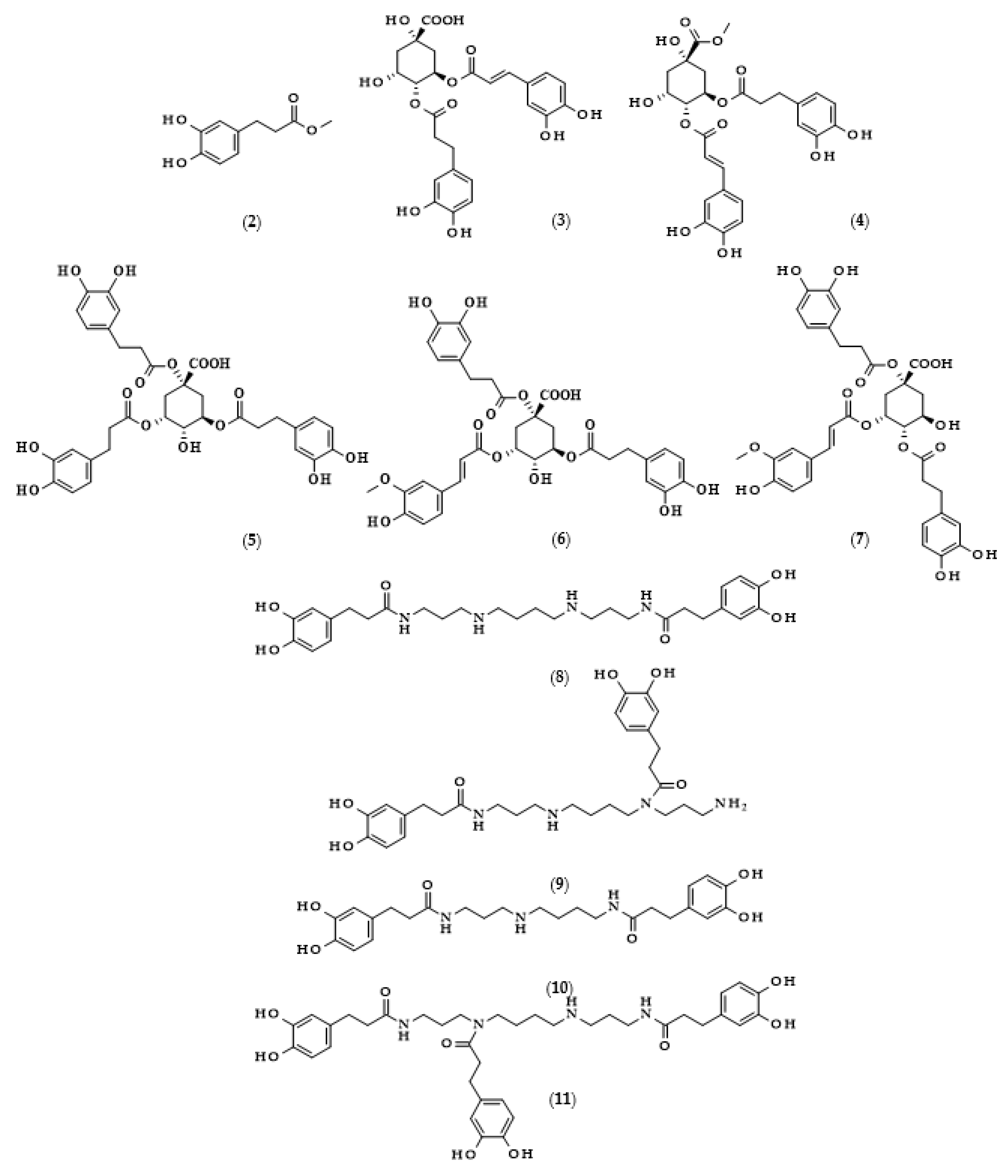

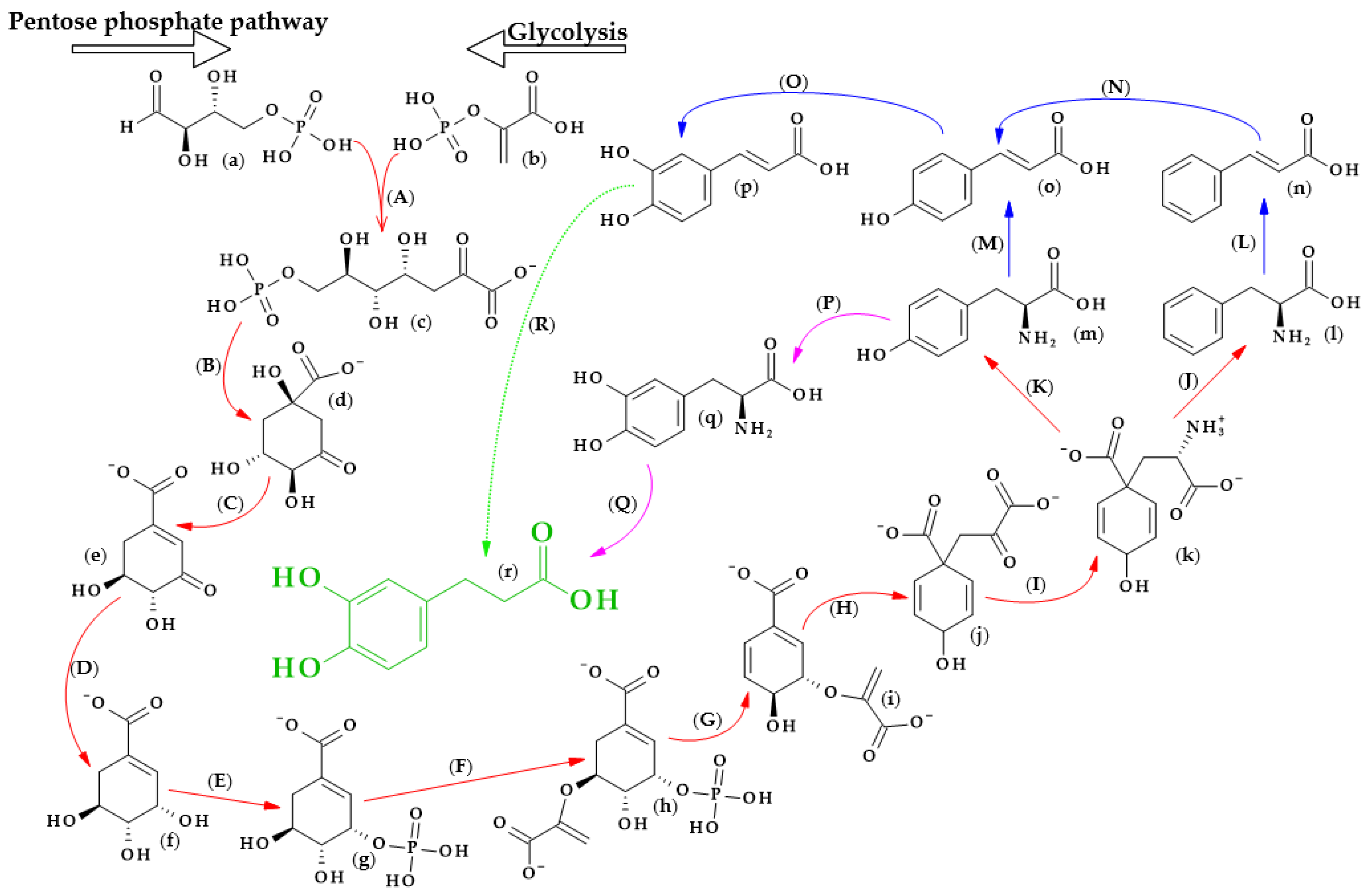
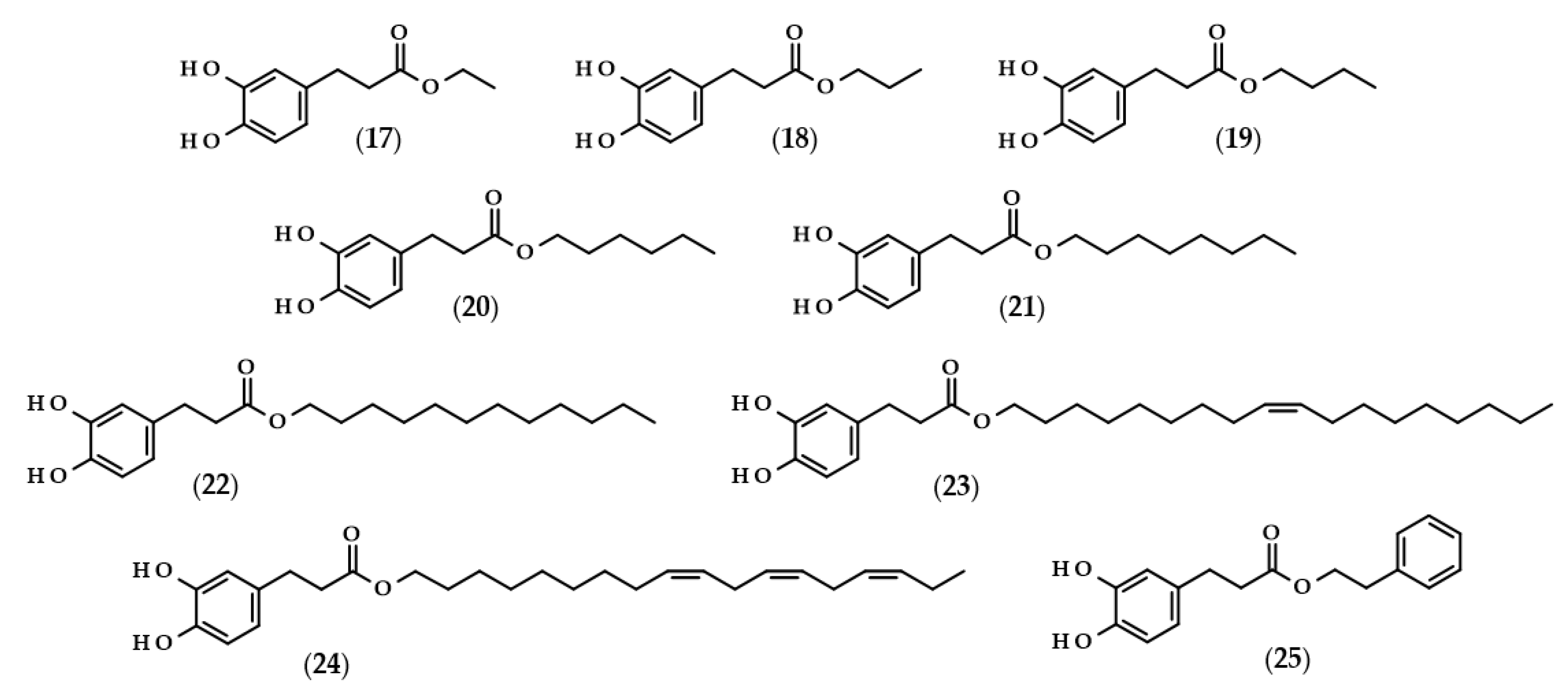
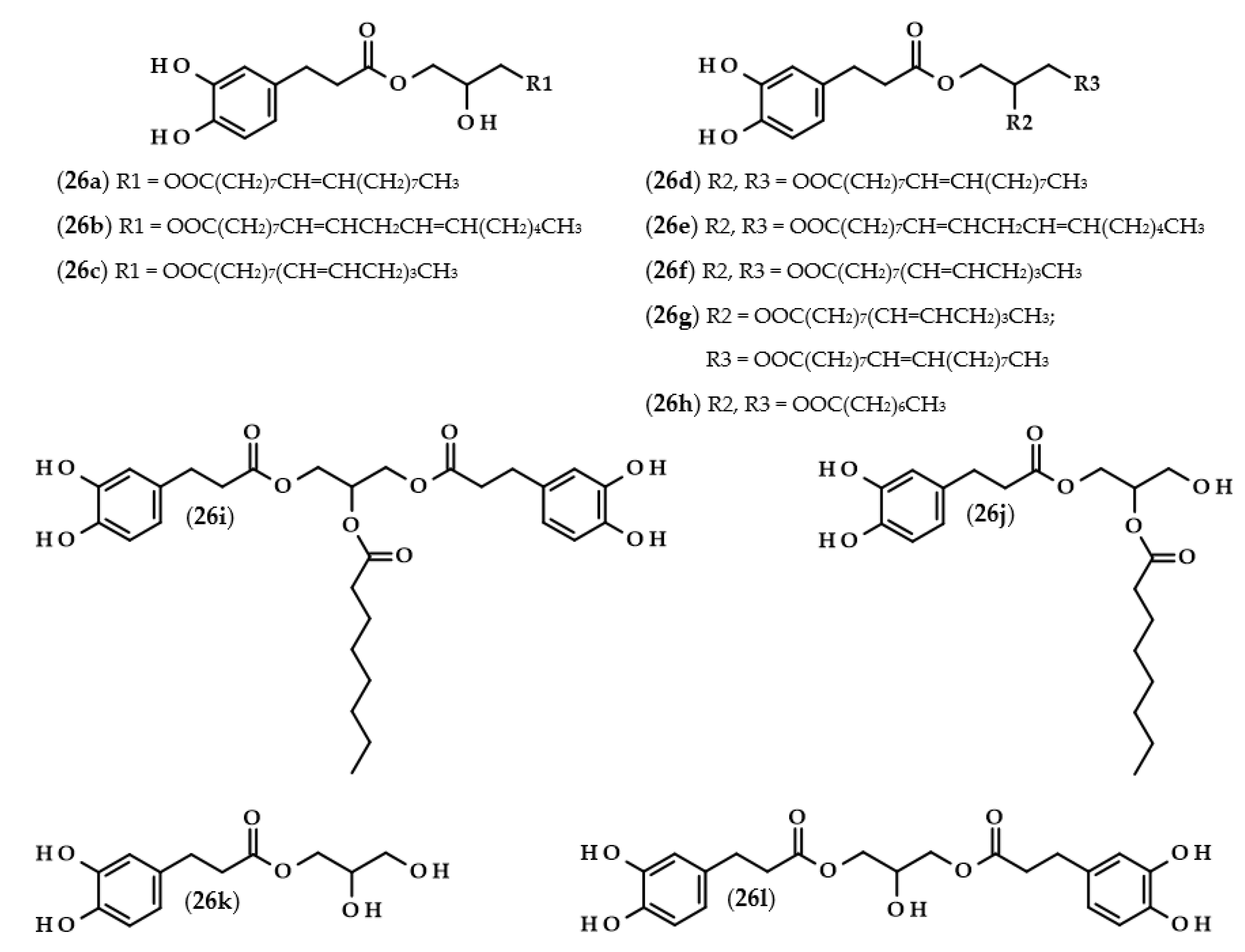
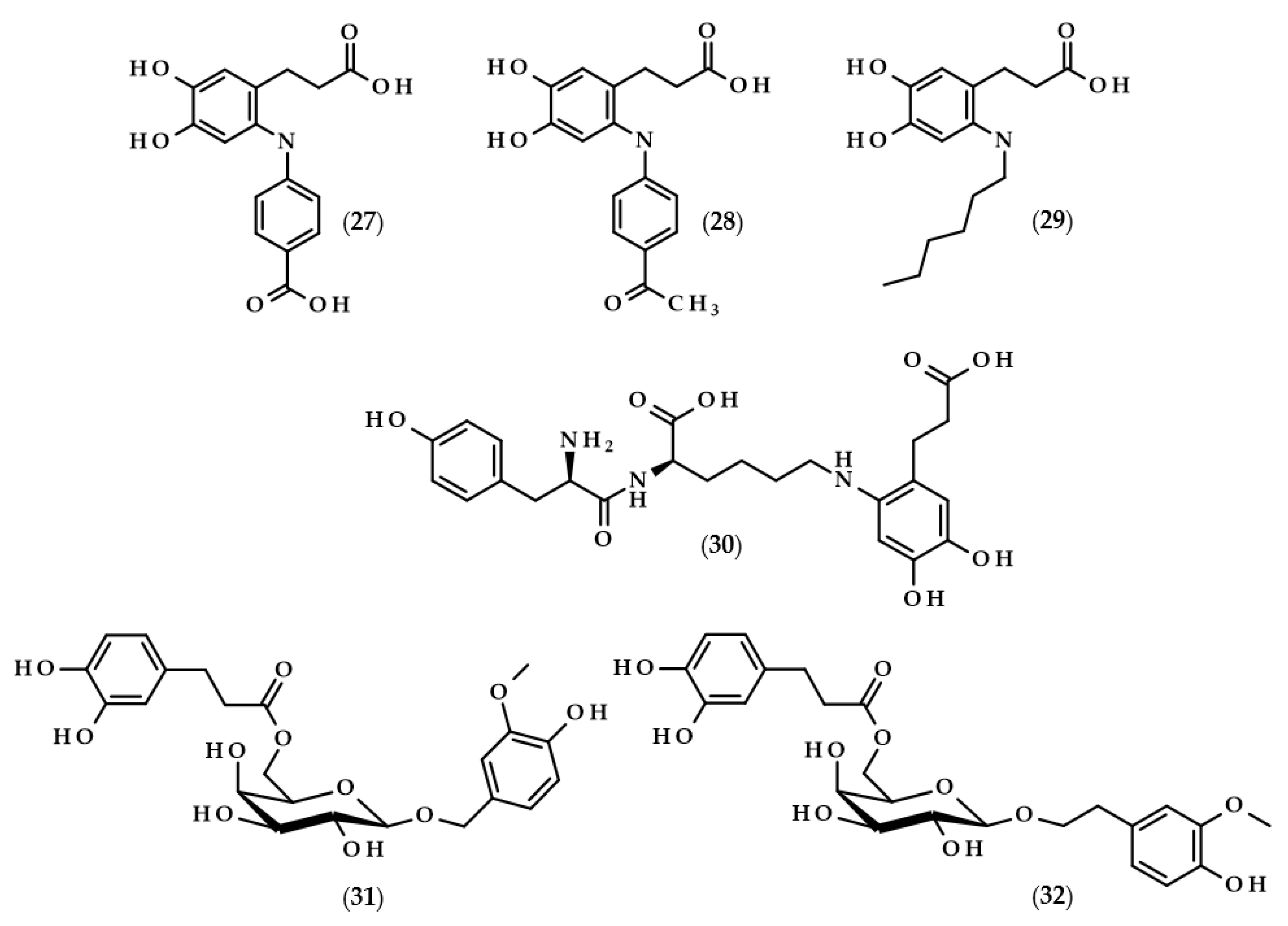



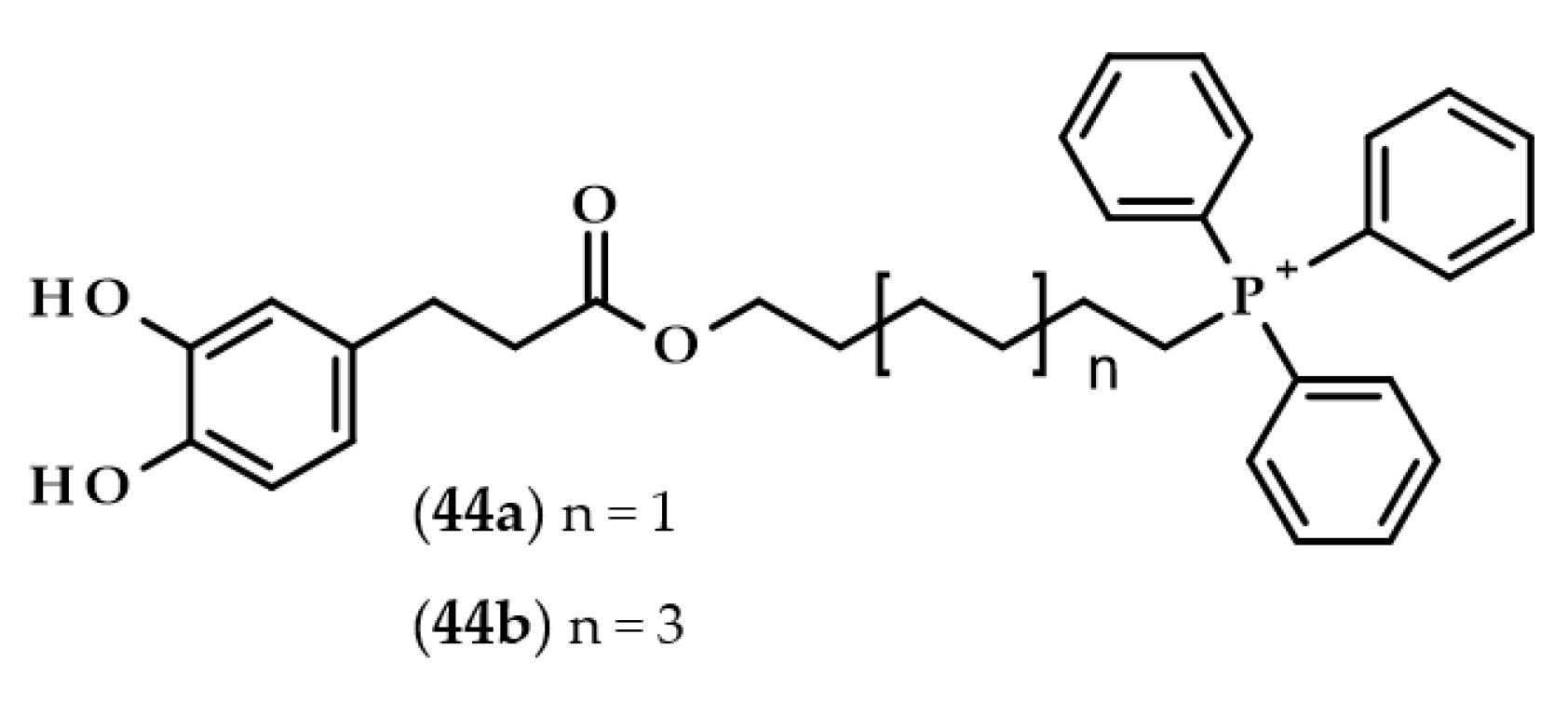
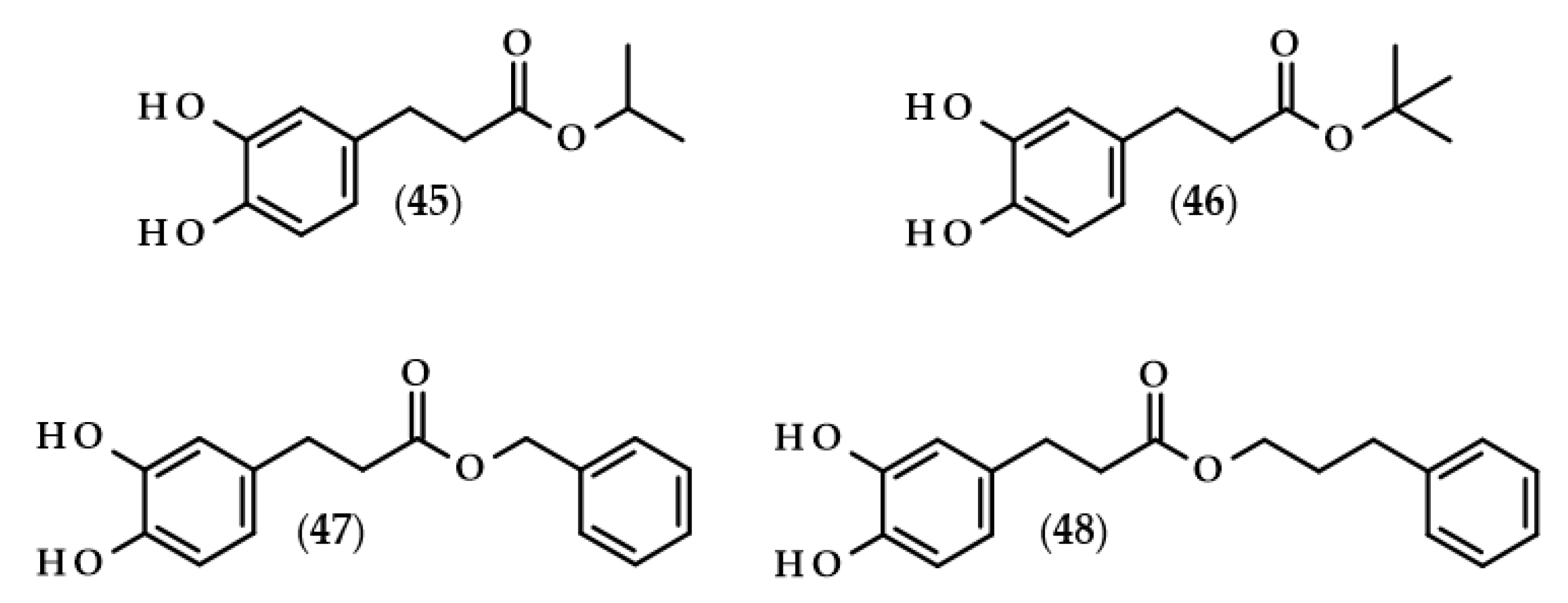

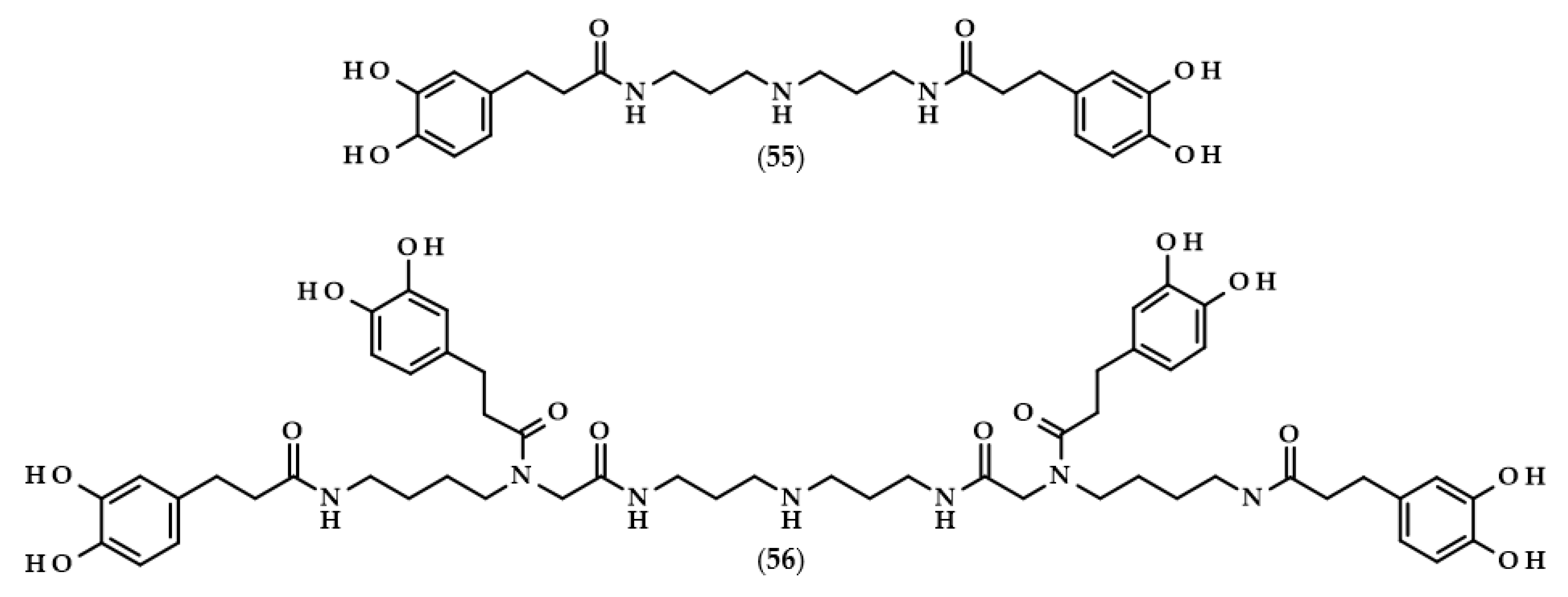

| Source | Concentration | Units | Reference |
|---|---|---|---|
| leaves of dyer’s woad (Isatis tinctoria) | 0.03 | mg/kg dry weight | [3] |
| white ray florets of chamomile (Matricaria recutita) | NS 1 | NS | [4] |
| stems of edible gynura (Gynura bicolor) | 90.91 | mg/g ethyl acetate fraction | [5] |
| transformed root cultures of Nepeta teydea | 10.53 | mg/kg freeze-dried roots | [6] |
| the aerial part of asian spicebush (Lindera glauca) | 0.306 | mg/kg dry weight | [7] |
| the whole grasses of spikemoss (Selaginella stautoniana) | 2.25 | mg/kg fresh weight | [8] |
| flowers of the Australian rainforest tree (Polyscias murrayi) | 352.32 | mg/kg fresh weight | [9] |
| concentrated chestnut rose (Rosa roxburghii) juice | 0.30 | g/L | [10] |
| Melipona beecheii Cuban polyfloral honey | NS | NS | [11] |
| Tantbouchte, Tafizaouine, Tazerzait and Tazizaout varieties of the Algerian ripe date palm fruit (Phoenix dactylifera) | NS | NS | [12] |
| black olive pericarp | 1.790 ± 0.030 | g/kg dry weight | [13] |
| black olive brine | 0.183 ± 0.001 | g/L | |
| Black Thasos olive cultivar | 5–10% | of total phenolics | [14] |
| Black Conservolia olive cultivar | 5–10% | of total phenolics | |
| Green Douro olive cultivar | 12 | mg/100 g pulp of fresh olives | |
| Black Cassanese olive cultivar | 3 | mg/100 g pulp of fresh olives | |
| Taggiasca Ligure Italian Extra Virgin Olive Oil | NS | NS | [15] |
| the red wine Lacrima di Morro d’Alba DOC produced in the region of Marche (Italy) | NS | NS | [16] |
| Asturian (Spain) natural ciders (n = 92) | 26.050–147.190 | mg/L | [17] |
| Asturian (Spain) natural ciders (n = 8) | 55.8–110.5 | mg/L | [18] |
| Compound | Source | Concentration | Units | Reference |
|---|---|---|---|---|
| methyl dihydrocaffeate (2) | fresh aerial parts of edible gynura (Gynura bicolor) | 45.45 | mg/kg ethyl acetate fraction | [5] |
| dihydrocaffeic acid hexose isomers | Romaine, iceberg, and butterhead lettuce (Lactuca sativa) cultivars | NS 1 | NS | [19] |
| esterified dihydrocaffeic acid with quinic acid | Glasswort (Salicornia herbacea L.) | 36.6–85.1 | mg/100 g dry weight | [20] |
| Tungtungmadic acid (3-caffeoyl-4-dihydrocaffeoyl quinic acid) (3) | Glasswort (Salicornia herbacea L.) | 8 | mg/kg dry weight | [21] |
| Tungtungmadic acid (3-caffeoyl-4-dihydrocaffeoyl quinic acid) (3) | Glasswort (Salicornia herbacea L.) | NS | NS | [22] |
| Tungtungmadic acid (3-caffeoyl-4-dihydrocaffeoyl quinic acid) (3) | Glasswort (Salicornia herbacea L.) | 8 | mg/kg dry weight | [23] |
| Tungtungmadic acid (3-caffeoyl-4-dihydrocaffeoyl quinic acid) (3) | Glasswort (Salicornia herbacea L.) | 0.5125 | mg/kg fresh weight | [24] |
| Salicornate (methyl 4-caffeoyl-3-dihydrocaffeoyl quinate) (4) | 0.5625 | |||
| Podospermic acid (1,3,5-tris(dihydrocaffeoyl)quinic acid) (5) | cutleaf vipergrass (Podospermum laciniatum, synonym: Scorzonera laciniata L.) | 358.10 | mg/kg fresh weight | [25] |
| Feruloylpodospermic acid A (1,5-bis(dihydrocaffeoyl)-3-feruloyl quinic acid) (6) | the aerial parts of Scorzonera divaricata | 82.03 | mg/kg dry weight | [26] |
| Feruloylpodospermic acid B (1,4-bis(dihydrocaffeoyl)-3-feruloyl quinic acid) (7) | the aerial parts of S. divaricata | 23.44 | ||
| Kukoamine A (N1,N12-bis(dihydrocaffeoyl)spermine) (8) | the root bark of Chinese boxthorn (Lycium chinense) | NS | NS | [27] |
| Kukoamine B (N1,N8-bis(dihydrocaffeoyl)spermine) (9) | the root bark of Chinese boxthorn (L. chinense) | 12.07 | mg/kg dry weight | [28] |
| Kukoamine A (N1,N12-bis(dihydrocaffeoyl)spermine) (8) | potato (Solanum tuberosum) tubers, tomato (Lycopersicon esculentum) and Nicotiana sylvestris | NS | NS | [29] |
| N1,N8-bis(dihydrocaffeoyl)spermidine (10) | NS | NS | ||
| N1,N4,N12-tris(dihydrocaffeoyl)spermine (11) | NS | NS | ||
| N1,N4,N8-tris(dihydrocaffeoyl)spermidine (12) | NS | NS | ||
| Kukoamine A (N1,N12-bis(dihydrocaffeoyl)spermine) (8) | the stems of Enoki (Flammulina velutipes) | NS | NS | [30] |
| N1,N8-bis(dihydrocaffeoyl)spermidine (10) | bitter fraction of Lulo (Solanum quitoense Lam.) | 67.2 | mg/kg | [31] |
| N1,N4,N8-tris(dihydrocaffeoyl)spermidine (12) | 100.8 | mg/kg | ||
| N1,N4,N8-tris(dihydrocaffeoyl)spermidine (12) | fruit pulp of Lulo | 1.6 | mg/kg | |
| freeze-dried Lulo fruits | 25.1 | mg/kg | ||
| spray-dried Lulo fruits | 25.0 | mg/kg | ||
| (3α,21β)-Lycophlegmariol A (13) | the methanol extract of common tassel fern (Lycopodium phlegmaria L.) | 4.54 | mg/kg dry weight | [32] |
| (3β,21β)-Lycophlegmariol B (14) | 5.17 | |||
| (3β,21α)-Lycophlegmariol D (15) | 29.54 | |||
| (3β,21α)-Lycophlegmarin (16) | 2.64 | |||
| (3α,21β)-Lycophlegmariol A (13) | the aerial parts of Huperzia phlegmaria (L. phlegmaria L.) | 10.00 | mg/kg dry weight | [33] |
| Compound | Cancer Cell Line | IC50 (mM) * | Reference |
|---|---|---|---|
| methyl dihydrocaffeate (2) | mouse leukemia cell line L1210 | 0.024 | [108] |
| ethyl dihydrocaffeate (17) | 0.023 | ||
| isopropyl dihydrocaffeate (45) | 0.019 | ||
| butyl dihydrocaffeate (19) | 0.020 | ||
| tert-butyl dihydrocaffeate (46) | 0.024 | ||
| hexyl dihydrocaffeate (20) | 0.009 | ||
| octyl dihydrocaffeate (21) | 0.009 | ||
| benzyl dihydrocaffeate (47) | 0.022 | ||
| phenethyl dihydrocaffeate (25) | 0.012 | ||
| 3-phenylpropyl dihydrocaffeate (48) | 0.010 | ||
| methyl dihydrocaffeate (2) | breast cancer cell line MCF-7 | 0.115 | |
| ethyl dihydrocaffeate (17) | 0.105 | ||
| isopropyl dihydrocaffeate (45) | 0.069 | ||
| butyl dihydrocaffeate (19) | 0.110 | ||
| tert-butyl dihydrocaffeate (46) | 0.050 | ||
| hexyl dihydrocaffeate (20) | 0.105 | ||
| octyl dihydrocaffeate (21) | 0.060 | ||
| benzyl dihydrocaffeate (47) | 0.120 | ||
| phenethyl dihydrocaffeate (25) | 0.132 | ||
| 3-phenylpropyl dihydrocaffeate (48) | 0.129 | ||
| dihydrocaffeic acid (1) | human melanoma cell line SK-MEL-24 | 2.200 | [110] |
| dihydrocaffeic acid (1) | leukemic cell line U-937 | >2.000 | [111] |
Disclaimer/Publisher’s Note: The statements, opinions and data contained in all publications are solely those of the individual author(s) and contributor(s) and not of MDPI and/or the editor(s). MDPI and/or the editor(s) disclaim responsibility for any injury to people or property resulting from any ideas, methods, instructions or products referred to in the content. |
© 2023 by the author. Licensee MDPI, Basel, Switzerland. This article is an open access article distributed under the terms and conditions of the Creative Commons Attribution (CC BY) license (https://creativecommons.org/licenses/by/4.0/).
Share and Cite
Zieniuk, B. Dihydrocaffeic Acid—Is It the Less Known but Equally Valuable Phenolic Acid? Biomolecules 2023, 13, 859. https://doi.org/10.3390/biom13050859
Zieniuk B. Dihydrocaffeic Acid—Is It the Less Known but Equally Valuable Phenolic Acid? Biomolecules. 2023; 13(5):859. https://doi.org/10.3390/biom13050859
Chicago/Turabian StyleZieniuk, Bartłomiej. 2023. "Dihydrocaffeic Acid—Is It the Less Known but Equally Valuable Phenolic Acid?" Biomolecules 13, no. 5: 859. https://doi.org/10.3390/biom13050859
APA StyleZieniuk, B. (2023). Dihydrocaffeic Acid—Is It the Less Known but Equally Valuable Phenolic Acid? Biomolecules, 13(5), 859. https://doi.org/10.3390/biom13050859






